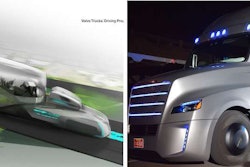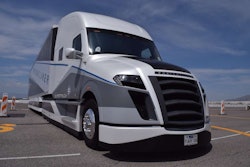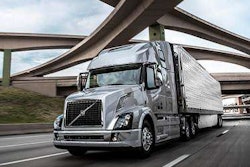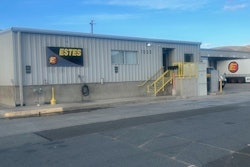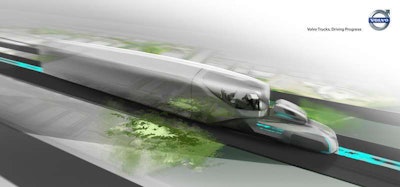
“We are putting a lot of effort into this area to gain extra advantage in our products,” said Göran Nyberg, president of Volvo Trucks North America regarding fuel efficiency improvements. “It’s about drivetrain optimization and aerodynamics, and also about finding new ways of building a truck and fine-tuning specifications for dedicated routes and needs. No longer does one size and design fit all needs.”
Volvo’s 2016 model-year tractors have incorporated a number of SuperTruck project-related advancements, including a number of powertrain and tractor fairing design changes, which have resulted in added fuel efficiency gains of 3.5 percent for aerodynamic performance improvements and 2 percent for powertrain improvements.
Volvo Group North America’s Tony Greszler, vice president of government and industry relations, previewed the company’s forthcoming predictive cruise concept with predictive shifting. “As the truck approaches a hill, the terrain information is preprogrammed into the truck and it knows altitude change and the location of the hill’s crest. As a truck comes into the hill it automatically speeds the truck to delay downshifting, controls speed coming over the hill and uses the truck’s momentum and stored energy on the downhill portion to accelerate and get better roll-off.”
In an update of Phase 2 of the National Highway Traffic Safety Administration’s greenhouse gas emissions and fuel economy standards, Greszler said the delay from 2024 to 2027 could mean more stringent measures as the agency received pressure from environmental groups.
Depending on the final rule, OEMs may be required to use waste heat recovery systems, which Greszler says amounts to essentially a second engine system on the truck, adding weight and maintenance costs.
“Truck buyers would be the losers,” said Greszler. “A separate engine standard would be redundant. If reason doesn’t prevail, the industry could face a mandate that actually reduces total vehicle efficiency. We need to design for fleet applications, not government regulations.”
Connectivity opens doors to new technology
Nyberg said with technology advances and vehicle-to-vehicle communications, there is far more potential to improve safety in the trucking industry. “Connectivity and new technology will help to avoid accidents in a far greater way going forward,” he said. “Connectivity will be the next game changer for the industry. Not in five or 10 years, but two to three years. It will change the way we work and communicate and take care of products and equipment. We at Volvo have decided to be a leader in connectivity in our industry.”
Susan Alt, senior vice president of public affairs for Volvo Group North America, said one such concept is platooning vehicles, adding that autonomous vehicles may not be a reality during our lifetime.
“Platooning will probably come to market first,” said Alt. “The technology exists today, we just need rules and regulations to allow it.”
As Alt explained, Volvo’s vision for a platooning solution involves only two trucks, one lead vehicle piloted by a driver and a second trailing vehicle with a driver seated behind the wheel in case he needs to take control. The second vehicle would have a video display with a camera feed of road conditions in front of the lead vehicle. “The real benefit is fuel efficiency,” she said. “The first truck gets better efficiency because or reduced wind drag behind the trailer, and the second truck gets better draft behind the first truck.”
Like autonomous trucks, platooning solutions also face regulatory and public acceptance hurdles.
“In California, we are working on legisltation that would allow platooning of two or three trucks,” said Alt. “Currently the distance between the platooning vehicles is different than current tailgating laws. We are proposing just two-truck platoons on long, straight interstate routes as the general public begins to accept it.”
Jeff Cotner, chief designer, exterior, for Volvo Trucks North America, shared long-term visions for how technology could impact truck design and freight movement.
Future-generation platooning could eliminate the need for all but one driver in the pilot vehicle. “We like the idea of a [driver-controlled] pilot truck,” said Cotner, who added that physical connections between the tractor and trailers may not be necessary. “Maybe tractor is just an air splitter and the fifth wheel is no longer needed. The system could automatically widen trailer gaps at low speeds and tighten them at higher speeds.”




